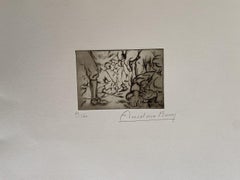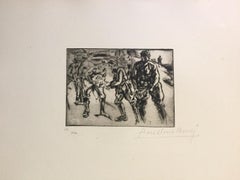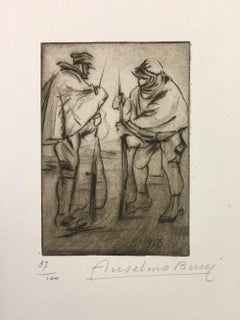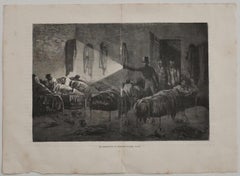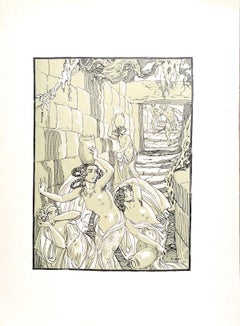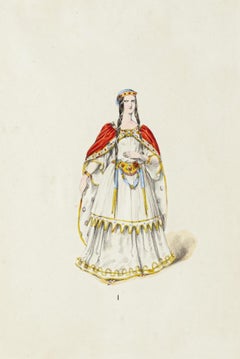Early 20th Century Figurative Prints
to
1,976
2,429
599
238
65
76
Overall Width
to
Overall Height
to
1,408
263
241
139
128
37
20
10
2
2
1
1
170
108
56
55
43
3,543
7,595
26,098
6,838
294
652
1,428
1,265
1,341
2,290
3,769
5,336
2,815
1,276
3,037
2,410
977
17
2,788
1,522
1,328
1,083
837
835
568
274
196
184
166
157
151
147
132
123
112
86
74
73
1,226
1,059
611
435
359
326
1,258
1,573
1,303
Period: Early 20th Century
Military - Original Etching by Anselmo Bucci - 1917s
Located in Roma, IT
"Military" 1917s is a beautiful print in etching technique, realized by Anselmo Bucci (1887-1955).
Hand signed. Numbered 61/100 of prints on the lower left. On the lower left corner...
Category
Modern Early 20th Century Figurative Prints
Materials
Etching
$315 Sale Price
25% Off
La Chaîne - Etching by Anselmo Bucci - 1917
Located in Roma, IT
Image dimensions: 9.5 x 13.5 cm.
Hand signed. Edition of 100 prints on Hollande paper. From the collection: “Croquis du Front Italien” , published in Paris by D'Alignan editions. An...
Category
Futurist Early 20th Century Figurative Prints
Materials
Drypoint, Etching
$315 Sale Price
25% Off
Le Releve - Original Etching by Anselmo Bucci - 1915
Located in Roma, IT
Image dimensions: 12.5 x 8.5 cm.
Hand signed. Edition of 100 prints on Hollande paper. From the collection: “Croquis du Front Italien”, published in Paris by D'Alignan editions. Ans...
Category
Futurist Early 20th Century Figurative Prints
Materials
Drypoint, Etching
$270 Sale Price
25% Off
The Dormitory - Lithograph by C. Laplante - Early 20th Century
Located in Roma, IT
The Dormitory is an original lithograph, realized by C. Laplante.
Signed on the plate on the lower right.
Titled on the lower center, with the scripts on the rear.
In good conditi...
Category
Modern Early 20th Century Figurative Prints
Materials
Lithograph
The Escape of the Bacchantes - Original Lithograph by Ferdinand Bac - 1922
Located in Roma, IT
The Escape of the Bacchantes is an original modern artwork realized by Ferdinand Bac (1859 - 1952) in 1922.
Signed and dated on plate on the lower right corner: F. Bac 1922.
Original Lithograph on ivory paper.
Perfect conditions.
The Escape of the Bacchantes is an elegant Liberty Lithograph realized by Ferdinand Bac in the second decade of the XX Century in France. The work, in full Liberty style, represents some women covered by transparent veils who are running with amphorae on their heads. The scene is very dynamic; behind them, several men are running behind them. The figures are in a structure covered by sqared bricks and are walking quickly up the stairs.
Ferdinand Bac (1859 - 1952). Ferdinand-Sigismond Bach, known as Ferdinand Bac was a French cartoonist, artist and writer, son of an illegitimate nephew of the Emperor Napoleon. As a young man, he mixed in the fashionable world of Paris of the Belle Époque, and was known for his caricatures, which appeared in popular journals. He also traveled widely in Europe and the Mediterranean. In his fifties, he began a career as a landscape gardener. He attended Adolphe Thiers, Gambetta, Richard Wagner, Victor Hugo, Taine, Villiers de L'Isle-Adam, Paul Verlaine, Maurice Barrès, Barbey d'Aurevilly, Alphonse Daudet, Guy de Maupassant, Verdi, Gounod, Pierre de Nolhac, and many more other famous people of the time. He established himself as one of the first cartoonists and caricaturists of his time, as famous as Albert Robida...
Category
Art Nouveau Early 20th Century Figurative Prints
Materials
Lithograph
Theatrical Costume - Original Lithograph - Early 20th Century
Located in Roma, IT
Theatrical Costume is a splendid lithograph engraved by Anonymous Artist in the Early 20th Century.
The state of preservation of the artwork is excellent.
Image Container: 53 x 28 ...
Category
Modern Early 20th Century Figurative Prints
Materials
Lithograph
$270 Sale Price
25% Off
Ready to Dance - Original Pochoir - 1920
Located in Roma, IT
Ready to dance is an original pouchoir on ivory-colored paper glued on cardboard, realized by Anonymous Artist of the 20th Century, in 1920.
In excellent conditions: as good as new....
Category
Modern Early 20th Century Figurative Prints
Materials
Stencil
The Soldier and the Bacchants - Original Lithograph by Ferdinand Bac - 1922
Located in Roma, IT
The Soldier and the Bacchants is an original modern artwork realized by Ferdinand Bac (1859 - 1952) in 1922.
Signed and dated on plate on the lower left corner: F. Bac 1922.
Origin...
Category
Art Nouveau Early 20th Century Figurative Prints
Materials
Lithograph
Figures on Red - Original Woodcut by Mino Maccari - Mid-20th Century
By Mino Maccari
Located in Roma, IT
Figures in Red is an original modern artwork realized in the first half of the XX Century by the Italian artist Mino Maccari (Siena, 1898 - Rome, 1989).
Original Lithograph on paper...
Category
Modern Early 20th Century Figurative Prints
Materials
Woodcut
The Coronation - Original Lithograph by F. Bac - 1922
Located in Roma, IT
The Coronation is an original modern artwork realized by Ferdinand Bac (1859 - 1952) in the 1920s.
Original Lithograph on ivory paper.Image dimensions: 19 x 14 cm.
Signed and dated on plate on the lower right corner: F. Bac 1922.
Excellent conditions.
The Coronation is an excellent Liberty Style artwork realized by the French artist Ferdinand Bac in the Second decade of the XX Century. The work depicts a female figure bent over a man seated on a throne who is offering her a crown of flowers. The scene is enriched by the other characters that are carrying vases full of flowers.
This work has been realized the French artist Ferdinand Bac (1859 - 1952). Ferdinand-Sigismond Bach, known as Ferdinand Bac was a French cartoonist, artist and writer, son of an illegitimate nephew of the Emperor Napoleon. As a young man, he mixed in the fashionable world of Paris of the Belle Époque, and was known for his caricatures, which appeared in popular journals. He also traveled widely in Europe and the Mediterranean. In his fifties, he began a career as a landscape gardener. He attended Adolphe Thiers, Gambetta, Richard Wagner, Victor Hugo, Taine, Villiers de L'Isle-Adam, Paul Verlaine, Maurice Barrès, Barbey d'Aurevilly, Alphonse Daudet, Guy de Maupassant, Verdi, Gounod, Pierre de Nolhac, and many more other famous people of the time. He established himself as one of the first cartoonists and caricaturists of his time, as famous as Albert Robida...
Category
Art Nouveau Early 20th Century Figurative Prints
Materials
Lithograph
Nymphs in the Cave - Original Lithograph by Ferdinand Bac - 1922
Located in Roma, IT
Nymphs in the Cave is an original modern artwork realized by Ferdinand Bac (1859 - 1952) in 1922.
Signed and dated on plate on the lower left corner: F....
Category
Art Nouveau Early 20th Century Figurative Prints
Materials
Lithograph
$270 Sale Price
25% Off
Woman - Original Zincograph by F. Reifs after G. Stadelmann - 1905
Located in Roma, IT
Woman is an original zincography on paper realized by F. Reifs after G. Stadelmann , in 1905.
This Specially Zincography representing a woman's Portrait. The title of the work "Carm...
Category
Modern Early 20th Century Figurative Prints
Materials
Paper
$180 Sale Price
25% Off
La Sera - Woodcut on Paper by Adolfo De Karolis - 1906
Located in Roma, IT
La Sera is an original woodcut on ivory-colored paper realized by Adolfo De Karolis.
The state of preservation is very good.
Signed and titled, Ad...
Category
Art Nouveau Early 20th Century Figurative Prints
Materials
Lithograph
$270 Sale Price
25% Off
Specchio (Mirror)- Original Woodcut on Paper by Giovanni Guerrini - 20th Century
Located in Roma, IT
Specchio (Mirror) is an original woodcut on paper realized by G. Guerrini.
Very good condition.
Included passepartout: 40 x 30 cm.
Category
Early 20th Century Figurative Prints
Materials
Woodcut
Military - Etching by Anselmo Bucci - 1917
Located in Roma, IT
"Military" 1917s is a beautiful print in etching technique, realized by Anselmo Bucci (1887-1955).
Hand signed. Numbered 61/100 of prints on the lower left. On the lower left corner...
Category
Modern Early 20th Century Figurative Prints
Materials
Etching
$270 Sale Price
25% Off
The Stolen Kiss - Original Lithograph by F. Bac - 1922
Located in Roma, IT
The Stolen Kiss is an original modern artwork realized by Ferdinand Bac (1859 - 1952) in 1922.
Original Lithograph on ivory paper.
Signed and dated on plate on the lower left corne...
Category
Art Nouveau Early 20th Century Figurative Prints
Materials
Lithograph
$270 Sale Price
25% Off
The Tale - Original Lithograph by F. Bac - 1922
Located in Roma, IT
The Tale is an original modern artwork realized by Ferdinand Bac (1859 - 1952) in 1922.
Original Lithograph on ivory paper.
Signed and dated on plate on the lower right corner: F. ...
Category
Art Nouveau Early 20th Century Figurative Prints
Materials
Lithograph
$270 Sale Price
25% Off
The Carriers of the Amphorae - Original Lithograph by F. Bac - 1922
Located in Roma, IT
The Carriers of Amphorae is an original modern artwork realized by Ferdinand Bac (1859 - 1952) in 1922.
Original Lithograph on ivory paper.
Signed and dated on plate on the lower right corner: F. Bac 1922.
Very good conditions.
The Carriers of Amphorae is an very beautiful Liberty Style lithograph realized by the French artist Ferdinand Bac in the Second decade of the XX Century. The work depicts some women carrying amphorae on their heads. Some of them cover up with their clothes and turn to a man. In the background we see a seascape with buildings and columns.
This work has been realized the French artist Ferdinand Bac (1859 - 1952). Ferdinand-Sigismond Bach, known as Ferdinand Bac was a French cartoonist, artist and writer, son of an illegitimate nephew of the Emperor Napoleon. As a young man, he mixed in the fashionable world of Paris of the Belle Époque, and was known for his caricatures, which appeared in popular journals. He also traveled widely in Europe and the Mediterranean. In his fifties, he began a career as a landscape gardener. He attended Adolphe Thiers, Gambetta, Richard Wagner, Victor Hugo, Taine, Villiers de L'Isle-Adam, Paul Verlaine, Maurice Barrès, Barbey d'Aurevilly, Alphonse Daudet, Guy de Maupassant, Verdi, Gounod, Pierre de Nolhac, and many more other famous people of the time. He established himself as one of the first cartoonists and caricaturists of his time, as famous as Albert Robida...
Category
Art Nouveau Early 20th Century Figurative Prints
Materials
Lithograph
$270 Sale Price
25% Off
The Escape of Women - Original Lithograph by F. Bac - 1922
Located in Roma, IT
The Escape of the Women is an original modern artwork realized by Ferdinand Bac (1859 - 1952) in 1922.
Original Lithograph on ivory paper.
Signed and dated on plate on the lower ri...
Category
Art Nouveau Early 20th Century Figurative Prints
Materials
Lithograph
$270 Sale Price
25% Off
Baccanale - Original Lithograph by F. Bac - 1922
Located in Roma, IT
Baccanale is an original modern artwork realized by Ferdinand Bac (1859 - 1952) in 1922.
Original Lithograph on ivory paper.
Signed and dated on plate on the lower left corner: F. Bac 1922.
Perfect conditions.
Baccanale is an excellent Liberty Style lithograph realized by the French artist Ferdinand Bac in the Second decade of the XX Century. The work depicts a very movimented scene with several female figures in the night singing and playing ancient instruments. The scene is surrounded by columns and, on the upper right corner, there is the silhouette of a temple.
This work has been realized the French artist Ferdinand Bac (1859 - 1952). Ferdinand-Sigismond Bach, known as Ferdinand Bac was a French cartoonist, artist and writer, son of an illegitimate nephew of the Emperor Napoleon. As a young man, he mixed in the fashionable world of Paris of the Belle Époque, and was known for his caricatures, which appeared in popular journals. He also traveled widely in Europe and the Mediterranean. In his fifties, he began a career as a landscape gardener. He attended Adolphe Thiers, Gambetta, Richard Wagner, Victor Hugo, Taine, Villiers de L'Isle-Adam, Paul Verlaine, Maurice Barrès, Barbey d'Aurevilly, Alphonse Daudet, Guy de Maupassant, Verdi, Gounod, Pierre de Nolhac, and many more other famous people of the time. He established himself as one of the first cartoonists and caricaturists of his time, as famous as Albert Robida...
Category
Art Nouveau Early 20th Century Figurative Prints
Materials
Lithograph
$270 Sale Price
25% Off
The Weaving - Original Lithograph by F. Bac - 1922
Located in Roma, IT
The Weaving is an original modern artwork realized by Ferdinand Bac (1859 - 1952) in 1922.
Original Lithograph on ivory paper.
Perfect conditions.
The Weaving is an very beautiful Liberty Style lithograph realized by the French artist Ferdinand Bac in the Second decade of the XX Century. The work depicts Penelope with the maids who sing and play ancient instruments. The background is characterized by a very calm sea and a cliff, in the central part we see the shaft of a column full of leaves and curtains.
This work has been realized the French artist Ferdinand Bac (1859 - 1952). Ferdinand-Sigismond Bach, known as Ferdinand Bac was a French cartoonist, artist and writer, son of an illegitimate nephew of the Emperor Napoleon. As a young man, he mixed in the fashionable world of Paris of the Belle Époque, and was known for his caricatures, which appeared in popular journals. He also traveled widely in Europe and the Mediterranean. In his fifties, he began a career as a landscape gardener. He attended Adolphe Thiers, Gambetta, Richard Wagner, Victor Hugo, Taine, Villiers de L'Isle-Adam, Paul Verlaine, Maurice Barrès, Barbey d'Aurevilly, Alphonse Daudet, Guy de Maupassant, Verdi, Gounod, Pierre de Nolhac, and many more other famous people of the time. He established himself as one of the first cartoonists and caricaturists of his time, as famous as Albert Robida...
Category
Art Nouveau Early 20th Century Figurative Prints
Materials
Lithograph
$270 Sale Price
25% Off
Military - Etching by Anselmo Bucci - 1917
Located in Roma, IT
"Military" 1917s is a beautiful print in etching technique, realized by Anselmo Bucci (1887-1955).
Hand signed. Numbered 89/100 of prints on the lower left. On the lower left corner...
Category
Modern Early 20th Century Figurative Prints
Materials
Etching
$225 Sale Price
25% Off
The Couple - Original Lithograph by F. Bac - 1922
Located in Roma, IT
The Couple is an original modern artwork realized by Ferdinand Bac (1859 - 1952) in 1922.
Original Lithograph on ivory paper.
Signed and dated on plate on the lower right corner: F...
Category
Art Nouveau Early 20th Century Figurative Prints
Materials
Lithograph
$270 Sale Price
25% Off
The Bath of Venus - Original Lithograph by F. Bac - 1922
Located in Roma, IT
The Bath of Venus is an original modern artwork realized by Ferdinand Bac (1859 - 1952) in 1922.
Original Lithograph on ivory paper.Image dimensions: 19 x 14 cm.
Signed and dated o...
Category
Art Nouveau Early 20th Century Figurative Prints
Materials
Lithograph
$270 Sale Price
25% Off
Handmaids and Sailors - Original Lithograph by F. Bac - 1922
Located in Roma, IT
Handmaids and Sailors is an original modern artwork realized by Ferdinand Bac (1859 - 1952) in 1922.
Original Lithograph on ivory paper.
Signed and dated on plate on the lower left...
Category
Art Nouveau Early 20th Century Figurative Prints
Materials
Lithograph
$270 Sale Price
25% Off
The Men and the Column - Original Lithograph by F. Bac - 1922
Located in Roma, IT
The Men and the Column is an original modern artwork realized by Ferdinand Bac (1859 - 1952) in 1922.
Original Lithograph on ivory paper.
Signed and dated on plate on the lower rig...
Category
Art Nouveau Early 20th Century Figurative Prints
Materials
Lithograph
$270 Sale Price
25% Off
Enfant à accroupi - Etching and drypoint - Early 1900
Located in Roma, IT
Image dimensions: 15.7 x 10.5 cm.
Enfant à accroupi is a superb original drypoint on paper, realized at the beginning of XX century by an unidentified artist. Unsigned
This print s...
Category
Early 20th Century Figurative Prints
Materials
Drypoint, Etching
$216 Sale Price
25% Off
Le Basileus Chasse
Located in San Francisco, CA
Artist: Jean-Louis Forain (French, 1852-1931)
Title: lLe Basileus Chasse
Year: 1918
Medium: Lithograph
Edition: Numbered 266/300 in pencil
Paper: Wove
Size paper: 15 x 22.25 in...
Category
Impressionist Early 20th Century Figurative Prints
Materials
Lithograph
FRANKIE AND JOHNNIE or HIM
By John Sloan
Located in Portland, ME
Sloan, John (American, 1871-1951). FRANKIE AND JOHNNIE. or HIM Morse 236. Etching, 1928. Edition of 100 (but only 50 were printed, by Platt). Dated and Titled in the plate, and Signed in pencil by Sloan and inscribed "100 Proofs," and also signed by Peter Platt. With tack holes and deckled edges. 5 x 8 inches, 126 x 203 mm. (plate), 8 1/2 x 12 1/4 inches (sheet). In excellent condition.
From Morse:
" A small chorus singing 'Frankie and Johnnie' crowds the tiny stage of the Provincetown Players Theater in MacDougal Street. An episode from E. E. Cummings' intelligent and entertaining production, HIM." (Sloan writing in 1945).
"HIM" is about as thrilling an evening's entertainment as I have ever experienced. I liked it thoroughly -- I do not claim to understand it -- I do not believe that a work of art can be, nor need be understood, even by the maker. It seemed to me to be a glimpse inside the cranium of an artist-poet." (Sloan in a letter to James Light, the director of the play)
Though Morse says the stars were Hemsley Williams and Goldye Steiner, it was actually Hemliey Winfield (1907 - 1934), the founder of the New Negro Art Theater Dance Group. This company was very successful and highly regarded. It appeared in the Metropolitan Opera's premier of Louis Gruenberg's setting of Eugene O'Neill's "The Emperor...
Category
Early 20th Century Figurative Prints
Materials
Etching
Der Abend - Vintage Héliogravure by Franz von Bayros - Early 1900
Located in Roma, IT
"Der Abend" is a Black and white héliogravure on cream-colored cardboard realized by Choisy Le Conin, pseudonym of Franz Von Bayros (Agram, 1866 – Vienna, 1924).
From Mappe, a port...
Category
Symbolist Early 20th Century Figurative Prints
Materials
Engraving
Portrait - Original Etching on Paper - 1907
Located in Roma, IT
"Portrait" is an original print in etching on paper, realized by an Artist of XX Century.
The state of preservation of the artwork is very good.
Sheet dimension: 25.5 x 16.6 cm.
...
Category
Early 20th Century Figurative Prints
Materials
Etching
$233 Sale Price
25% Off
Ex Libris Mantero - Original Etching by M. Fingesten - 1930s
Located in Roma, IT
Ex Libris - Mantero is an original etching artwork realized by Michel Fingesten in the 1930s
Hand-signed on the lower center.
Numbered on the lower margin. Edition of 150.
Good c...
Category
Modern Early 20th Century Figurative Prints
Materials
Etching
$404 Sale Price
25% Off
Dans La Poudrière - Original Etching by Anselmo Bucci - 1917
Located in Roma, IT
Image dimensions: 24.5 x 19 cm.
Hand signed. Edition of 100 prints on Hollande paper. From the collection: “Croquis du Front Italien”, published in Paris by D'Alignan editions. Anse...
Category
Futurist Early 20th Century Figurative Prints
Materials
Drypoint, Etching
$315 Sale Price
25% Off
River - Original Lithograph by Marcel Roche - Early XX century
By Marcel Roche
Located in Roma, IT
River is a superb original lithograph realized at the beginning of the XX century by the French artist Marcel Roche (1890-1959).
The State of preservation is good and aged.
The art...
Category
Naturalistic Early 20th Century Figurative Prints
Materials
Lithograph
Samuel J. Woolf Antique Litho: First Aid Station at Seicheprey
Located in New York, NY
Samuel J. Woolf (American, 1880-1948)
First Aid Station at Seicheprey
Lithograph
Sight: 11 x 14 1/2 in.
Framed: 20 x 23 x 1 in.
Signed lower right: S. J. Woolf
Numbered lower left: 23/150
This print is based on Woolf 1918 oil painting: Front Line Dressing Station...
Category
American Modern Early 20th Century Figurative Prints
Materials
Lithograph
Landscape - Original Etching on Paper by Arthur Evershed - 1876
Located in Roma, IT
Landscape is an original etching artwork on paper realized in 1876 by Arthur Evershed (1836-1919), printed by Delatre London, hand-signed on the lower right.
The State of preservat...
Category
Modern Early 20th Century Figurative Prints
Materials
Etching
$449 Sale Price
25% Off
The Evocation - Woodcut - Early 20th Century
Located in Roma, IT
Image dimensions: 13x9.6 cm.
Man with landscape is an original woodcut realized by an artist of the 20th century, around 1920. Unreadable signature.
Good conditions except for some...
Category
Early 20th Century Figurative Prints
Materials
Woodcut
$539 Sale Price
25% Off
Spleen - Original Etching by Anselmo Bucci - 1917
Located in Roma, IT
Image dimensions: 9 x 21 cm.
Hand signed. Edition of 100 prints on Hollande paper. From the collection: “Croquis du Front Italien” , published in Paris by D'Alignan editions. Anse...
Category
Futurist Early 20th Century Figurative Prints
Materials
Drypoint, Etching
Kathe Kollwitz Original Etching, 1904 - "Junges Paar"
Located in Phoenix, AZ
Etching and Aquatint by German artist Kathe Kollwitz.
Titled: “Junges Paar.” Matted and unframed.
Created in Berlin, 1904. Image measures: 11 3/4"h x 12 ½” w.
Signed in pencil lower ...
Category
Early 20th Century Figurative Prints
Materials
Paper
Portrait - Original Etching by A.E. Guillez - 1908
Located in Roma, IT
Image dimensions: 13 x 9 cm.
Portrait is an original etching by Arthur Edmond Guillez (1865-1916) realized in 1908, which is the portrait of Rene Boulet, hand-signed and dated on ...
Category
Early 20th Century Figurative Prints
Materials
Etching
$216 Sale Price
25% Off
L‘ennemi est en Vue - Original Etching by Anselmo Bucci - 1915
Located in Roma, IT
Image dimensions: 11 x 13.5 cm.
Hand signed. Edition of 100 prints on Hollande paper. Here are represented some of the most important exponents of Futurism such as Marinetti and Boc...
Category
Futurist Early 20th Century Figurative Prints
Materials
Drypoint, Etching
$763 Sale Price
25% Off
Woman in the Garden - Original Etching - Early 20th Century
Located in Roma, IT
Woman in Garden is original etching on paper, realized by an Anonymous artist of the XX century, in 1925 ca, hand-signed, from an edition of 35 prints the firm is not readable, the ...
Category
Early 20th Century Figurative Prints
Materials
Drypoint, Etching
$179 Sale Price
25% Off
Landscape of the River - Original Lithograph by Jean Chapin - Early 1900
By Jean Chapin
Located in Roma, IT
Landscape of the River is an original lithograph realized by Jean Chapin in the XX century.
Signature stamp of the artist on the lower left margin.
Image dimension: 25 x 43 cm.
...
Category
Early 20th Century Figurative Prints
Materials
Lithograph
Les Mitrailleuses - Etching by Anselmo Bucci - 1917
Located in Roma, IT
Image dimensions: 18 x 14.5 cm.
Hand signed. Edition of 100 prints on Hollande paper. From the collection: “Croquis du Front Italien” , published in Paris by D'Alignan editions. Ans...
Category
Futurist Early 20th Century Figurative Prints
Materials
Drypoint, Etching
$314 Sale Price
25% Off
Extenués - Etching by Anselmo Bucci - 1917
Located in Roma, IT
Image dimensions: 6 x 8 cm.
Hand signed. Edition of 100 prints on Hollande paper. From the collection: “Croquis du Front Italien” , published in Paris by D'Alignan editions. Anselmo...
Category
Futurist Early 20th Century Figurative Prints
Materials
Drypoint, Etching
$179 Sale Price
25% Off
Bordellszene - Original Lithograph by Otto Gleichmann - 1924
Located in Roma, IT
Bordellszene is an original lithograph, realized by Otto Gleichmann in 1924, hand- signed and dated.
In very good conditions.
Here the artwork represents two men in Expressionistic...
Category
Expressionist Early 20th Century Figurative Prints
Materials
Lithograph
$1,260 Sale Price
25% Off
Sur la Grève - Original Lithograph by L. von Hoffmann - 1910 ca.
Located in Roma, IT
Sur la Grève is a red lithograph realized by the German artist Ludwig von Hofmann. It was published in the Gazette des Beaux Arts in 1910 (cfr.n. 1910.12 of the catalog Sanchez Seydo...
Category
Early 20th Century Figurative Prints
Materials
Lithograph
Heiligenblut, Austria
Located in San Francisco, CA
This artwork titled "Heiligenblut, Austria" c.1950 is a color etching by Austrian artist Luigi Kasimir 1881-1962. It is hand signed by the artiste's estate in pencil at the lower center. The plate mark (image) size is 7.75 x 5.75 inches, framed is 17.85 x 15.15 inches. It is framed in a wooden antique silver frame. It is in very good condition.
About the artist.
Luigi Kasimir was born in 1881 at Pettau, today Ptuj, Slovenia, then a part of the Austro-Hungarian monarchy. He inherited his talent from his ancestors; his grandfather was a painter and a poet, and his father an officer in the Habsburg army, who later became a professional painter. Kasimir attended the Vienna Academy of Art where he studied under Wilhelm Unger, who introduced him to the technique of the coloured etching, and also to his future wife, the artist Tanna Hoernes.[1] He died in 1962 in Grinzing, a suburb of Vienna.Kasimir was among the first to develop the technique of the coloured etching. Before this, prints were usually hand-coloured with the colour being applied in a casual, haphazard manner. Kasimir would first create a sketch usually in pastel, he then transferred the design on as many as four to six plates, printing one after the other and applying the colour on the plate, all done by hand.
Kasimir is mainly famous for his etchings, but he also produced some oil painting, as well as some pastels. One of his favourite genres was the landscape, or veduta. He demonstrated a predisposition street scenes, and tourist landmarks. He depicted places from all over Europe, mainly Italy, Austria, and Germany. He also travelled to the United States to do a series of etchings of famous sights ranging from urban landmarks such as New York City skyscrapers, to natural wonders like Yosemite Valley. Luigi Kasimir’s etchings...
Category
Realist Early 20th Century Figurative Prints
Materials
Etching
Honoré - Original Lithograph by French Master First Half 20th Century
Located in Roma, IT
Honoré is a contemporary artwork realized by an anonymous artist during the 20th century.
It is a black and white limited edition litograph. Our specimen is the number 16 of 50.
U...
Category
Early 20th Century Figurative Prints
Materials
Lithograph
Vintage New York Stock Exchange Print by William Anderson Sherwood
Located in New York, NY
William Anderson Sherwood (American, 1875-1951)
New York Stock Exchange, Early 20th century
Etching and aquatint
Sight: 16 1/4 x 13 in.
Frame...
Category
Realist Early 20th Century Figurative Prints
Materials
Etching, Aquatint
"Coriolan und seine Mutter" signed original woodcut
Located in Henderson, NV
Medium: original woodcut. Signed in pencil by Peter Trumm and printed in Germany in 1922 for the very rare "Die zweite Ganymed-Mappe" portfolio of "Das vierte Jahrbuch der Marees Ges...
Category
Expressionist Early 20th Century Figurative Prints
Materials
Woodcut
l'Adieu (The Fairwell)
Located in San Francisco, CA
Artist: Theophile Alexandre Steinlen (Swiss, 1859-1923)
Title: L'Adieu (The Fairwell)
Year: 1916
Medium: Lithograph
Edition: Numbered 381/400 in pencil
Paper: Creme wove
Image...
Category
Realist Early 20th Century Figurative Prints
Materials
Lithograph
The Village - Original Etching on Paper by J. Beltrand - Early 20th Century
Located in Roma, IT
The Small Village is an original artwork realized by Jacques Beltrand in the first decades of the XX Century.
Image dimensions: 17x20.5 cm.
Original etching on paper. Hand-signed in pencil by the artist on the lower left corner. Signed on plate on the lower right corner. Numbered in pencil on the lower right corner. First edition of 30 prints...
Category
Modern Early 20th Century Figurative Prints
Materials
Etching
Panel with Head - Lithograph on Paper by A. Moreau-Neret - Early 1900
Located in Roma, IT
Panel With Head is a mixed colored lithograph on paper, realized between the XX and the XIX century by Adrien Moreau-Neret.
Signed on the plate on the l...
Category
Modern Early 20th Century Figurative Prints
Materials
Lithograph
Donne sulla Spiaggia - Original Etching by Luigi Bartolini - First Half of 1900
Located in Roma, IT
Donne sulla spiaggia is an original artwork realized by Luigi Bartolini in the first half of the XX Century.
Original etching on paper. Image dimensions: 9.5 x 13 cm.
Edition of ...
Category
Early 20th Century Figurative Prints
Materials
Etching
Le Journaliste - Original Chromolithograph - 1901/02
Located in Roma, IT
Le Journaliste is an original chromolithograph, realized between 1901-1902.
This artwork is from L'Assiette au Beurre an illustrated French weekly satirical periodical illustrated b...
Category
Early 20th Century Figurative Prints
Materials
Lithograph
$314 Sale Price
25% Off
House on The River - Original Woodcut - First Half of 20th Century
Located in Roma, IT
House on The River is an original xylograph realized during the first half of 20th Century by an anonymous artist.
Monogram of the artist PP printed on the lower left margin,
The ...
Category
Modern Early 20th Century Figurative Prints
Materials
Woodcut
Golden Gate, San Francisco, California
Located in San Francisco, CA
This artwork titled "Golden Gate, San Francisco, California" c.1930 is a color etching on watermarked Kasimir Vienna paper by Austrian artist Luigi Kasimir, 1881-1962. It is hand sig...
Category
Realist Early 20th Century Figurative Prints
Materials
Etching
Propos d'un Intoxiqué - Lithograph after L.T. Foujita - 1928
Located in Roma, IT
Image dimensions: 20 x 15.2 cm.
After Leonard Tsuguharu Foujita Lithographic reproduction in colors, from the set of sixteen illustrations from Propos d’un intoxiqué, by Jules Boiss...
Category
Modern Early 20th Century Figurative Prints
Materials
Lithograph
Bellone - Original Woodcut by J. Beltrand After A. Rodin - Early 20th Century
Located in Roma, IT
Image dimensions: 18 x 11.5 cm.
Bellone is an engraving on wood realized by the French artist Jacques Beltrand. The following inscriptions are present: in the middle, inside the mat...
Category
Modern Early 20th Century Figurative Prints
Materials
Woodcut
Recently Viewed
View AllMore Ways To Browse
Fernando Castro Pacheco
Angel Bracho
Botello Paul
David Schluss Serigraph
Grun Poster
Hajime Namiki
Harold Altman November
Hearts Suite Peter Max
Henry Theophile Hildibrand
Henry Wright Kerr
Herschel Levit
Hirschfeld Charlie Chaplin
Hirschfeld Marilyn
Hirschfeld Marx Brothers
Hisashi Otsuka
Invader Kit
Ivan Valtchev
James A Pritchard
